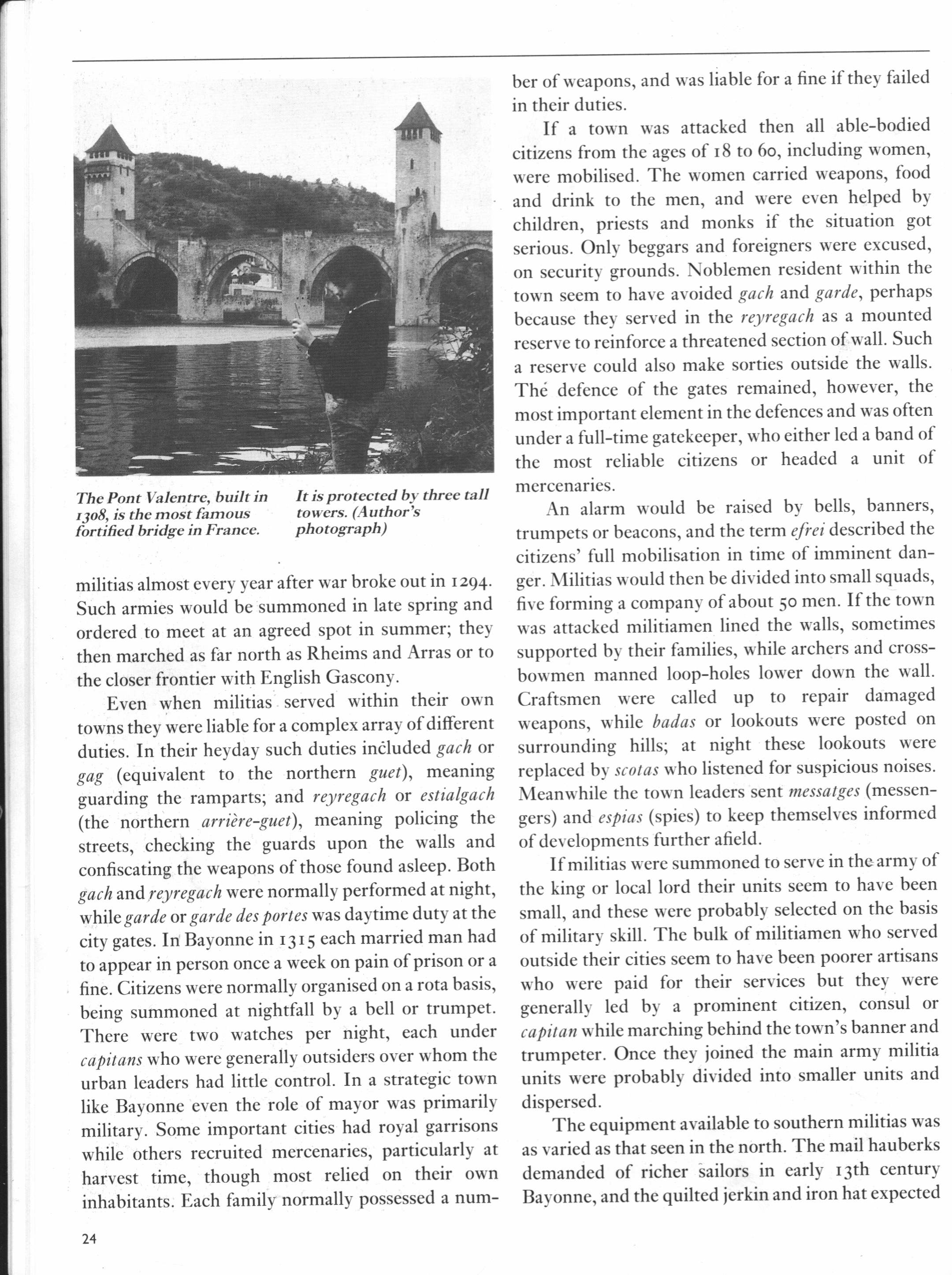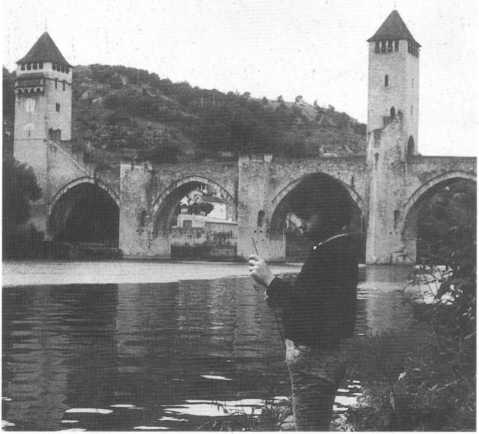m231$

r

The Pont Valentre, built in It is protectcd by three tali ijoS, is the most famous to wers. (Author’s fortibed bridge in France. photograph)
militias almost every year after war broke out in 1294. Such armies would be summoned in late spring and ordered to meet at an agreed spot in summer; they then marched as far north as Rheims and Arras or to the closer frontier with English Gascony.
Even when militias served within their own towns they were liable for a complex array of different duties. In their heyday such duties inćluded gach or gag (equivalent to the northern guet), meaning guarding the ramparts; and reyregach or estialgach (the northern arriere-guet), meaning policing the streets, checking the guards upon the walls and confiscating the weapons of those found asleep. Both gach and reyregach were normally performed at night, vih\\e. gardę or gardę des port es was daytime duty at the city gates. In Bayonne in 1315 each married man had to appear in person once a week on pain of prison or a fine. Citizens were normally organised on a rota basis, being summoned at nightfall by a beli or trumpet. There were two watches per night, each under capitans who were generally outsiders over whom the urban leaders had little control. In a strategie town like Bayonne even the role of mayor was primarily military. Some important cities had royal garrisons while others reeruited mercenaries, particularly at harvest time, though most relied on their own inhabitants. Each family normally possessed a num-ber of weapons, and was liable for a fine if they failed in their duties.
If a town was attacked then all able-bodied citizens from the ages of 18 to 60, including women, were mobilised. The women carried weapons, food and drink to the men, and were even helpcd by children, priests and monks if the situation got serious. Only beggars and foreigners were excused, on security grounds. Noblemen resident within the town seem to have avoided gach and gardę, perhaps because they served in the reyregach as a mounted reserve to reinforce a threatened section of wali. Such a reserve could also make sorties outside the walls. The defence of the gates remained, however, the most important element in the defences and was often under a full-time gatekeeper, w ho either led a band of the most reliable citizens or headed a unit of mercenaries.
An alarm would be raised by bells, banners, trumpets or beacons, and the term efrei described the citizens’ fuli mobilisation in time of imminent dan-ger. Militias would then be divided into smali squads, five forming a company of about 50 men. If the tow n was attacked militiamen lined the walls, sometimes supported by their families, while archers and cross-bowmen manned loop-holes lower down the wali. Craftsmen were called up to repair damaged weapons, while badas or lookouts were posted on surrounding hills; at night these lookouts were replaced by scotas w ho listened for suspicious noises. Mean while the town leaders sent messatges (messen-gers) and espias (spies) to keep themselves informed of developments further afield.
If militias were summoned to serve in thearmy of the king or local lord their units seem to have been smali, and these w ere probably selected on the basis of military skill. The bulk of militiamen who served outside their cities seem to have been poorer artisans who were paid for their services but they were generally led by a prominent citizen, consul or capitan w hile marching behind the town’s banner and trumpeter. Once they joined the main army militia units were probably divided into smaller units and dispersed.
The equipment awailable to Southern militias was as varied as that seen in the north. The mail hauberks demanded of richer sailors in early I3th century Bayonne, and the quilted jerkin and iron hat expected
24
Wyszukiwarka
Podobne podstrony:
dpp08 has brought me to the pinnacle of famę in llie weigltt lifting world. It is rather a new role
DSCF0022 ESSAYS IN SWEDISH HISTORY it is probably still true to say that the campaign of 1633 would
BVCommunityP22 My Community Can you describe your community? I live in It is in the State of Skill:
The geomorphological mapping in Poland is not being restricted to the registration and the location
MySQL software is Open Source. Open Source means that it is possible for anyone to use and modify th
Conseryation ethic: it is good, a social duty, to preserve the past (Lipę 1977; Lowenthal and
Foreword by Starost It is my great pleasure to be able to invite you to read the second volume of Są
jowtest 04 Ao a natter of interoat, it Is not a bacJ idea to soe hcw nany tincs you car. porfom the
mbs 019 MY BREATHDfG SYSTEM exlialation than during inhalation. The lungs strongcr, it is an excelle
15796 s&h 052 STKF.NGTII AND DEALTIT If you are in a great hurry, it is het tor not to eat at nil, o
The Medieval period in Great Britain (1066-1485) - 1066 - it s the most famous dat
which have appeared in our past Conference iroceedings and that although it is always our polic
s&h 037 3 STKRNUTIT AND HEALTH thiug else. Not direetly, of course, but in-directly, iu tbat it is t
więcej podobnych podstron